Our Group organises 3000+ Global Events every year across USA, Europe & Asia with support from 1000 more scientific Societies and Publishes 700+ ║┌┴¤═° Journals which contains over 50000 eminent personalities, reputed scientists as editorial board members.
║┌┴¤═° Journals gaining more Readers and Citations
700 Journals and 15,000,000 Readers Each Journal is getting 25,000+ Readers
Citations : 3330
Indexed In
- Index Copernicus
- Google Scholar
- Sherpa Romeo
- Open J Gate
- Genamics JournalSeek
- Academic Keys
- ResearchBible
- China National Knowledge Infrastructure (CNKI)
- Access to Global Online Research in Agriculture (AGORA)
- Electronic Journals Library
- RefSeek
- Hamdard University
- EBSCO A-Z
- OCLC- WorldCat
- SWB online catalog
- Virtual Library of Biology (vifabio)
- Publons
- Geneva Foundation for Medical Education and Research
- Euro Pub
- ICMJE
Useful Links
Recommended Journals
Related Subjects
Share This Page
In Association with
Mapping and detection of phylloxera in vineyards using UAVs, hyperspectral remote sensing and artificial intelligence
17th EURO BIOTECHNOLOGY CONGRESS
Felipe Gonzalez, Fernando Vanegas, Dmitry Bratanov, John Weiss and Kevin S Powell
Queensland University of Technology, Brisbane, Australia Plant Biosecurity Cooperative Research Centre, Australia AgriBio Centre, Australia Agriculture Victoria, Rutherglen, Australia
ScientificTracks Abstracts: J Biotechnol Biomater
DOI:
Abstract
The use of unmanned aerial vehicles (UAVS) or drones in agriculture and plant biosecurity is rapidly increasing. Grape phylloxera (Daktulsphaira vitifoliae Fitch) is a serious economically important invasive insect pest of European grapevine (Vitis vinifera L). Although widely present in most grape-growing countries worldwide, its distribution within Australia is limited, mainly due to strict biosecurity measures in place at farm, regional and state levels. As the insect is very small, and primarily lives underground on the roots of the grapevines, it is very hard to detect until the symptoms of infestation appear (slow stunted growth and premature yellowing of leaves), usually after 2-3 years (although in some instances this can be longer). This research, part of a Plant Biosecurity CRC project on ├ó┬?┬?Optimising plant biosecurity surveillance protocols for remote sensing using unmanned aerial systems├ó┬?┬Ł, evaluates the use of UAV based high resolution RBG, thermal, multi- and hyper-spectral imagery at detecting symptoms of phylloxera infestation at two different vineyards, multi-variety grapevines, at two separate time periods and under different levels of phylloxera infestation. Early detection of phylloxera within the first year would allow vineyard managers to implement phytosanitary measures to restrict or slow the spread of the pest and reduce future costs and losses in production. Previous research indicated that early infection of grapevines by phylloxera can be detected with hand-held spectro-radiometers and changes in leaf and canopy level reflectance were associated with changes in leaf chemistry. Datasets from each imagery type are compared to existing phylloxera detection practices; visual inspection, ground-based insect traps, soil DNA probes as well as being overlain with EM38 ground conductivity survey data. The ultimate aim of this study is to move towards a more targeted integrated approach for phylloxera detection and is the first study of its type to focus on a soil borne pest of biosecurity significance.Biography
Felipe Gonzalez is an Associate Professor in the Science and Engineering Faculty, Australia and team Leader for Integrated Intelligent Airborne Sensing Laboratory at the Queensland University of Technology, Australia. He holds a BE (Mech) and a PhD from the University of Sydney. His research explores bioinspired optimization, uncertainty based UAV path planning and UAVs for environmental monitoring. He leads the CRC plant biosecurity project evaluating unmanned aerial systems for deployment in plant biosecurity and the CRC PB 2135 optimizing surveillance protocols using unmanned aerial systems and developing pest risk models of buffel grass using unmanned aerial systems and statistical methods. He is a Chartered Professional Engineer and member of Professional Organizations including the RAeS, IEEE and AIAA.

